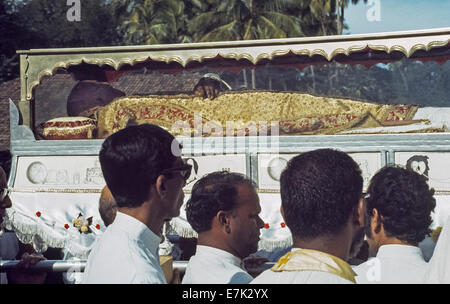 The body of Saint Francis Xavier is viewed through its glass and silver casket in 1974 while being paraded from its final resting place in the Basilica Bom Jesus to the nearby Se Cathedral during the Solemn Exposition of his sacred relics that occurs every 10 years in Goa, India. As the first Jesuit missionary and co-founder of the Society of Jesus, Xavier arrived in Goa in 1542 to restore Christianity to the Portuguese settlers there and elsewhere in Asia. The Pope declared him a saint 70 years after his death in 1552. Historical photo. Stock Photohttps://www.alamy.com/image-license-details/?v=1https://www.alamy.com/stock-photo-the-body-of-saint-francis-xavier-is-viewed-through-its-glass-and-silver-73563502.html
The body of Saint Francis Xavier is viewed through its glass and silver casket in 1974 while being paraded from its final resting place in the Basilica Bom Jesus to the nearby Se Cathedral during the Solemn Exposition of his sacred relics that occurs every 10 years in Goa, India. As the first Jesuit missionary and co-founder of the Society of Jesus, Xavier arrived in Goa in 1542 to restore Christianity to the Portuguese settlers there and elsewhere in Asia. The Pope declared him a saint 70 years after his death in 1552. Historical photo. Stock Photohttps://www.alamy.com/image-license-details/?v=1https://www.alamy.com/stock-photo-the-body-of-saint-francis-xavier-is-viewed-through-its-glass-and-silver-73563502.htmlRME7K2YX–The body of Saint Francis Xavier is viewed through its glass and silver casket in 1974 while being paraded from its final resting place in the Basilica Bom Jesus to the nearby Se Cathedral during the Solemn Exposition of his sacred relics that occurs every 10 years in Goa, India. As the first Jesuit missionary and co-founder of the Society of Jesus, Xavier arrived in Goa in 1542 to restore Christianity to the Portuguese settlers there and elsewhere in Asia. The Pope declared him a saint 70 years after his death in 1552. Historical photo.
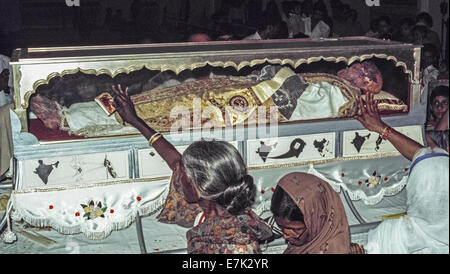 The body of Saint Francis Xavier is viewed through its glass and silver casket in 1974 inside the Se Cathedral after being brought from its final resting place in the nearby Basilica Bom Jesus during the Solemn Exposition of his sacred relics that occurs every 10 years in Goa, India. As the first Jesuit missionary and co-founder of the Society of Jesus, Xavier arrived in Goa in 1542 to restore Christianity to the Portuguese settlers there and elsewhere in Asia. The Pope declared him a saint 70 years after his death in 1552. Historical photo. Stock Photohttps://www.alamy.com/image-license-details/?v=1https://www.alamy.com/stock-photo-the-body-of-saint-francis-xavier-is-viewed-through-its-glass-and-silver-73563499.html
The body of Saint Francis Xavier is viewed through its glass and silver casket in 1974 inside the Se Cathedral after being brought from its final resting place in the nearby Basilica Bom Jesus during the Solemn Exposition of his sacred relics that occurs every 10 years in Goa, India. As the first Jesuit missionary and co-founder of the Society of Jesus, Xavier arrived in Goa in 1542 to restore Christianity to the Portuguese settlers there and elsewhere in Asia. The Pope declared him a saint 70 years after his death in 1552. Historical photo. Stock Photohttps://www.alamy.com/image-license-details/?v=1https://www.alamy.com/stock-photo-the-body-of-saint-francis-xavier-is-viewed-through-its-glass-and-silver-73563499.htmlRME7K2YR–The body of Saint Francis Xavier is viewed through its glass and silver casket in 1974 inside the Se Cathedral after being brought from its final resting place in the nearby Basilica Bom Jesus during the Solemn Exposition of his sacred relics that occurs every 10 years in Goa, India. As the first Jesuit missionary and co-founder of the Society of Jesus, Xavier arrived in Goa in 1542 to restore Christianity to the Portuguese settlers there and elsewhere in Asia. The Pope declared him a saint 70 years after his death in 1552. Historical photo.
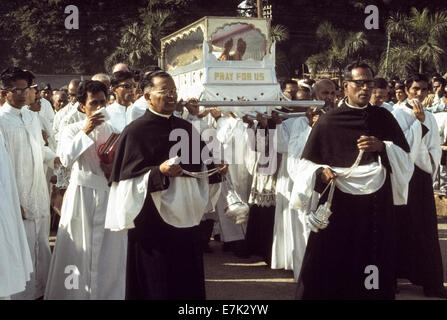 The body of Saint Francis Xavier is viewed through its glass and silver casket in 1974 while being paraded from its final resting place in the Basilica Bom Jesus to the nearby Se Cathedral during the Solemn Exposition of his sacred relics that occurs every 10 years in Goa, India. As the first Jesuit missionary and co-founder of the Society of Jesus, Xavier arrived in Goa in 1542 to restore Christianity to the Portuguese settlers there and elsewhere in Asia. The Pope declared him a saint 70 years after his death in 1552. Historical photo. Stock Photohttps://www.alamy.com/image-license-details/?v=1https://www.alamy.com/stock-photo-the-body-of-saint-francis-xavier-is-viewed-through-its-glass-and-silver-73563501.html
The body of Saint Francis Xavier is viewed through its glass and silver casket in 1974 while being paraded from its final resting place in the Basilica Bom Jesus to the nearby Se Cathedral during the Solemn Exposition of his sacred relics that occurs every 10 years in Goa, India. As the first Jesuit missionary and co-founder of the Society of Jesus, Xavier arrived in Goa in 1542 to restore Christianity to the Portuguese settlers there and elsewhere in Asia. The Pope declared him a saint 70 years after his death in 1552. Historical photo. Stock Photohttps://www.alamy.com/image-license-details/?v=1https://www.alamy.com/stock-photo-the-body-of-saint-francis-xavier-is-viewed-through-its-glass-and-silver-73563501.htmlRME7K2YW–The body of Saint Francis Xavier is viewed through its glass and silver casket in 1974 while being paraded from its final resting place in the Basilica Bom Jesus to the nearby Se Cathedral during the Solemn Exposition of his sacred relics that occurs every 10 years in Goa, India. As the first Jesuit missionary and co-founder of the Society of Jesus, Xavier arrived in Goa in 1542 to restore Christianity to the Portuguese settlers there and elsewhere in Asia. The Pope declared him a saint 70 years after his death in 1552. Historical photo.
 The body of Saint Francis Xavier is viewed through its glass and silver casket in 1974 inside the Se Cathedral after being brought from its final resting place in the nearby Basilica Bom Jesus during the Solemn Exposition of his sacred relics that occurs every 10 years in Goa, India. As the first Jesuit missionary and co-founder of the Society of Jesus, Xavier arrived in Goa in 1542 to restore Christianity to the Portuguese settlers there and elsewhere in Asia. The Pope declared him a saint 70 years after his death in 1552. Historical photo. Stock Photohttps://www.alamy.com/image-license-details/?v=1https://www.alamy.com/stock-photo-the-body-of-saint-francis-xavier-is-viewed-through-its-glass-and-silver-73563500.html
The body of Saint Francis Xavier is viewed through its glass and silver casket in 1974 inside the Se Cathedral after being brought from its final resting place in the nearby Basilica Bom Jesus during the Solemn Exposition of his sacred relics that occurs every 10 years in Goa, India. As the first Jesuit missionary and co-founder of the Society of Jesus, Xavier arrived in Goa in 1542 to restore Christianity to the Portuguese settlers there and elsewhere in Asia. The Pope declared him a saint 70 years after his death in 1552. Historical photo. Stock Photohttps://www.alamy.com/image-license-details/?v=1https://www.alamy.com/stock-photo-the-body-of-saint-francis-xavier-is-viewed-through-its-glass-and-silver-73563500.htmlRME7K2YT–The body of Saint Francis Xavier is viewed through its glass and silver casket in 1974 inside the Se Cathedral after being brought from its final resting place in the nearby Basilica Bom Jesus during the Solemn Exposition of his sacred relics that occurs every 10 years in Goa, India. As the first Jesuit missionary and co-founder of the Society of Jesus, Xavier arrived in Goa in 1542 to restore Christianity to the Portuguese settlers there and elsewhere in Asia. The Pope declared him a saint 70 years after his death in 1552. Historical photo.
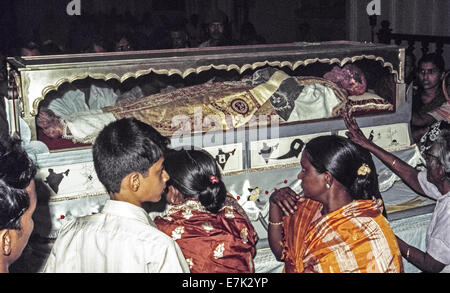 The body of Saint Francis Xavier is viewed through its glass and silver casket in 1974 inside the Se Cathedral after being brought from its final resting place in the nearby Basilica Bom Jesus during the Solemn Exposition of his sacred relics that occurs every 10 years in Goa, India. As the first Jesuit missionary and co-founder of the Society of Jesus, Xavier arrived in Goa in 1542 to restore Christianity to the Portuguese settlers there and elsewhere in Asia. The Pope declared him a saint 70 years after his death in 1552. Historical photo. Stock Photohttps://www.alamy.com/image-license-details/?v=1https://www.alamy.com/stock-photo-the-body-of-saint-francis-xavier-is-viewed-through-its-glass-and-silver-73563498.html
The body of Saint Francis Xavier is viewed through its glass and silver casket in 1974 inside the Se Cathedral after being brought from its final resting place in the nearby Basilica Bom Jesus during the Solemn Exposition of his sacred relics that occurs every 10 years in Goa, India. As the first Jesuit missionary and co-founder of the Society of Jesus, Xavier arrived in Goa in 1542 to restore Christianity to the Portuguese settlers there and elsewhere in Asia. The Pope declared him a saint 70 years after his death in 1552. Historical photo. Stock Photohttps://www.alamy.com/image-license-details/?v=1https://www.alamy.com/stock-photo-the-body-of-saint-francis-xavier-is-viewed-through-its-glass-and-silver-73563498.htmlRME7K2YP–The body of Saint Francis Xavier is viewed through its glass and silver casket in 1974 inside the Se Cathedral after being brought from its final resting place in the nearby Basilica Bom Jesus during the Solemn Exposition of his sacred relics that occurs every 10 years in Goa, India. As the first Jesuit missionary and co-founder of the Society of Jesus, Xavier arrived in Goa in 1542 to restore Christianity to the Portuguese settlers there and elsewhere in Asia. The Pope declared him a saint 70 years after his death in 1552. Historical photo.
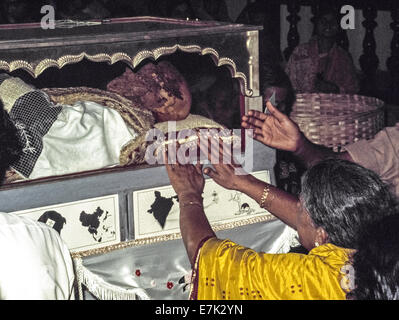 The body of Saint Francis Xavier is viewed through its glass and silver casket in 1974 inside the Se Cathedral after being brought from its final resting place in the nearby Basilica Bom Jesus during the Solemn Exposition of his sacred relics that occurs every 10 years in Goa, India. As the first Jesuit missionary and co-founder of the Society of Jesus, Xavier arrived in Goa in 1542 to restore Christianity to the Portuguese settlers there and elsewhere in Asia. The Pope declared him a saint 70 years after his death in 1552. Historical photo. Stock Photohttps://www.alamy.com/image-license-details/?v=1https://www.alamy.com/stock-photo-the-body-of-saint-francis-xavier-is-viewed-through-its-glass-and-silver-73563497.html
The body of Saint Francis Xavier is viewed through its glass and silver casket in 1974 inside the Se Cathedral after being brought from its final resting place in the nearby Basilica Bom Jesus during the Solemn Exposition of his sacred relics that occurs every 10 years in Goa, India. As the first Jesuit missionary and co-founder of the Society of Jesus, Xavier arrived in Goa in 1542 to restore Christianity to the Portuguese settlers there and elsewhere in Asia. The Pope declared him a saint 70 years after his death in 1552. Historical photo. Stock Photohttps://www.alamy.com/image-license-details/?v=1https://www.alamy.com/stock-photo-the-body-of-saint-francis-xavier-is-viewed-through-its-glass-and-silver-73563497.htmlRME7K2YN–The body of Saint Francis Xavier is viewed through its glass and silver casket in 1974 inside the Se Cathedral after being brought from its final resting place in the nearby Basilica Bom Jesus during the Solemn Exposition of his sacred relics that occurs every 10 years in Goa, India. As the first Jesuit missionary and co-founder of the Society of Jesus, Xavier arrived in Goa in 1542 to restore Christianity to the Portuguese settlers there and elsewhere in Asia. The Pope declared him a saint 70 years after his death in 1552. Historical photo.